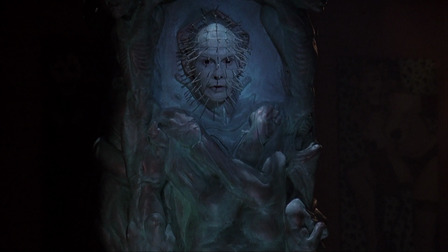← Back to Reviews
in
An aspiring journalist investigates a strange series of events that are connected to a sculpture of demonic origin.
Watching this back-to-back with Hellbound: Hellraiser II really underlines the paradoxical way in which the concept of Hellraiser is at once primed to support sequel after sequel and yet probably shouldn't have been allowed to progress past the second one (and maybe not even reach that far in the first place). It definitely gets more than a little silly as it transports the action from the suitably Gothic gloom of '80s London to the scuzzy mean streets of '90s New York and cranks up the absurdity to a notable level even for a franchise that had established a fondness for distorted leather-bound monsters and flesh-ripping instruments of torture. Regular antagonist Pinhead (Doug Bradley) returns in the form of a cursed statue that feeds on blood at the same time that intrepid reporter Joey (Terry Farrell) is looking to find out the truth behind a classically Hellraiser-looking death she witnesses. These threads intertwine with others - most notably involving an arrogant nightclub owner who buys the Pinhead statue, but also B-plots involving Joey dreaming of the Vietnam War and Pinhead's true soul being trapped in purgatory - and it all adds up to...something?
Hellraiser III functions best as a sort of feverish shark-jump for the franchise that fills out the gaps it tears in its own concept by borrowing from other prominent horror movies (there's an obvious Nightmare on Elm Street vibe where Pinhead rattles off overwrought one-liners and dream worlds figure into the plot). The shift in tone is reflected in everything from cinematography that alternates between garish and crusty to a soundtrack that supplants the typically ominous orchestra with a considerable number of metal and industrial songs. Of course, this signals that the movie is less about trying to create an overwhelmingly scary experience like its predecessors and more about drawing as much crazy weirdness out of the concept as possible while still creating a semi-coherent serialised narrative. As such, I think it's appreciable to a degree because there is at least some level of crazy fun to be had with the proceedings - while that only does so much to elevate this rather messy threequel from badness to campy mediocrity, something just managing that is enough.
#3 - Hellraiser III: Hell on Earth
Anthony Hickox, 1992

Anthony Hickox, 1992

An aspiring journalist investigates a strange series of events that are connected to a sculpture of demonic origin.
Watching this back-to-back with Hellbound: Hellraiser II really underlines the paradoxical way in which the concept of Hellraiser is at once primed to support sequel after sequel and yet probably shouldn't have been allowed to progress past the second one (and maybe not even reach that far in the first place). It definitely gets more than a little silly as it transports the action from the suitably Gothic gloom of '80s London to the scuzzy mean streets of '90s New York and cranks up the absurdity to a notable level even for a franchise that had established a fondness for distorted leather-bound monsters and flesh-ripping instruments of torture. Regular antagonist Pinhead (Doug Bradley) returns in the form of a cursed statue that feeds on blood at the same time that intrepid reporter Joey (Terry Farrell) is looking to find out the truth behind a classically Hellraiser-looking death she witnesses. These threads intertwine with others - most notably involving an arrogant nightclub owner who buys the Pinhead statue, but also B-plots involving Joey dreaming of the Vietnam War and Pinhead's true soul being trapped in purgatory - and it all adds up to...something?
Hellraiser III functions best as a sort of feverish shark-jump for the franchise that fills out the gaps it tears in its own concept by borrowing from other prominent horror movies (there's an obvious Nightmare on Elm Street vibe where Pinhead rattles off overwrought one-liners and dream worlds figure into the plot). The shift in tone is reflected in everything from cinematography that alternates between garish and crusty to a soundtrack that supplants the typically ominous orchestra with a considerable number of metal and industrial songs. Of course, this signals that the movie is less about trying to create an overwhelmingly scary experience like its predecessors and more about drawing as much crazy weirdness out of the concept as possible while still creating a semi-coherent serialised narrative. As such, I think it's appreciable to a degree because there is at least some level of crazy fun to be had with the proceedings - while that only does so much to elevate this rather messy threequel from badness to campy mediocrity, something just managing that is enough.
